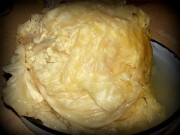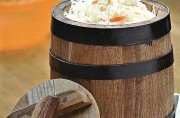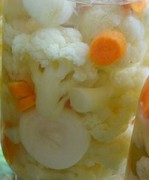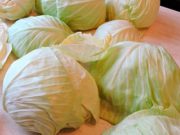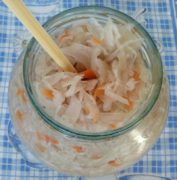Bulgarian sauerkraut is a homemade recipe or a tasty and healthy vegetable platter for the winter.
I tried sauerkraut prepared in this way on vacation in Bulgaria and one local resident was happy to share with me her recipe for homemade cabbage for the winter. Preparing this tasty and healthy vegetable platter for the winter is not at all difficult. All you need is your desire and a cool place to store the barrels with the product.
For our homemade recipe, you need to take strong, medium-sized heads of white cabbage and a few forks of red cabbage to give the assorted vegetables a beautiful color.
How to make sauerkraut at home in Bulgarian style.

We clean the heads from the upper leaves and make a cross-shaped cut at the base of the stalk, placing them with the stalks up in a tub.
Fill the cabbage with brine (only chilled) until the heads are completely covered.
On top of the cabbage forks, you need to place a cross or a wooden circle in the tub, and put oppression on top.
Separately, I would like to talk about small tricks from my own experience in preparing such homemade cabbage, which I will generously share with you.
Usually, I prepare 50 kg of cabbage. To pickle such a quantity of vegetables, you need to prepare a brine: 20 liters of water and approximately 1.6 kg of coarse table salt.
First, how to prepare the brine: you need to dissolve table salt in boiling water and if suddenly the brine solution turns out to be cloudy, strain it through several layers of gauze.
It is important in this recipe for homemade cabbage to correctly determine how much salt it will require for proper pickling. If there is too much salt, the salting process will slow down and the cabbage may spoil. If there is not enough salt, the fermentation process accelerates, the cabbage is salted faster, but due to the lack of salt, which in Bulgarian sauerkraut acts as a natural preservative, the cabbage will become acidic and also spoil.
If we put insufficient or excessive amount of salt in the brine, do not be upset, we have the time and opportunity to fix everything. Taste the brine; if there is not enough salt, it will thicken and taste bland. In this case, be sure to drain the brine and, after boiling it, add salt to it again (remember, cabbage will not tolerate hot brine). If the solution turns out to be too steep and the cabbage does not want to be salted, drain the brine, pour out part of it, which we simply replace with cold water. After any manipulations with the brine concentration, it must be drained and poured back into the tub for several days in a row.
To make the fermentation process more intense, you need to put some barley grains on the bottom of the tub.
While our cabbage is being salted, to ensure even pickling, we need to drain and pour the brine back into the tub with pickling several times. This procedure must be done in the first week of salting - every other day, in the second - after two to three days, and then (until complete salting) it is enough to do this once a week.
After the cabbage is completely fermented (until ready), cover the tub with pickles tightly with a lid. And put it in a cool room with a temperature of 10 - 12 degrees Celsius.

If you do everything correctly (and I tried to describe everything in detail so that you get the recipe right), then in a month or a month and a half you will already be trying your first sauerkraut. I either finely chop it, flavoring it with olive-garlic dressing, or make cabbage rolls. This cabbage is also suitable for making soups or cabbage soup.

